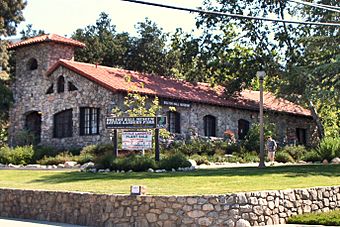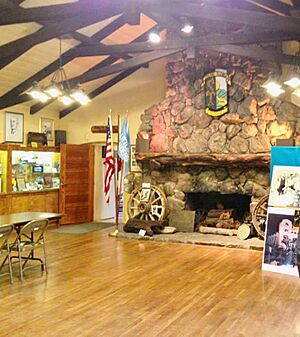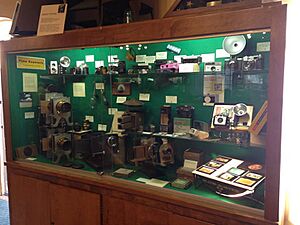Bolton Hall (California) facts for kids
|
Bolton Hall
|
|
 |
|
| Lua error in Module:Location_map at line 420: attempt to index field 'wikibase' (a nil value). | |
| Location | 10110 Commerce Ave., Tujunga, California |
|---|---|
| Built | 1913 |
| Architect | George Harris |
| Architectural style | American Craftsman Mission Revival |
| NRHP reference No. | 71000159 |
Quick facts for kids Significant dates |
|
| Added to NRHP | November 23, 1971 |
Bolton Hall is a historic stone building in Tujunga, Los Angeles, California. It was built in 1913 in the American Craftsman style. This special building first served as a community center for a unique community called Los Terrenitos.
Over the years, Bolton Hall had many different jobs. From 1920 to 1957, it was an American Legion hall, a public library, Tujunga City Hall, and even a jail! After 1957, the building closed and sat empty for over 20 years. People debated whether to tear it down or fix it up. Since 1980, the Little Landers Historical Society has run Bolton Hall as a local history museum.
Contents
What is Bolton Hall?
Bolton Hall is a very old and important building in Tujunga. It has seen many changes in the area and played a big part in the community's history. Today, it helps people learn about the past.
A Dream Community: Los Terrenitos
In the early 1900s, the land where Tujunga now stands was mostly empty. It was once part of a large ranch called Rancho Tujunga. In 1913, a man named William Ellsworth Smythe and his partner, M.V. Hartranft, started a special community there. They called it Los Terrenitos, which means "The Little Lands" in Spanish.
Smythe was a leader of the Utopian "Little Landers" movement. This movement believed that families could live well and build a strong community by farming just one or two acres of land. Smythe had already helped start similar communities in other places. In Tujunga, people could buy an acre of land for $800 and start a new, independent life.
Building Bolton Hall
Bolton Hall was built in 1913 by George Harris. He called himself a "nature builder" and used natural materials. Harris named the building after Bolton Hall, a New York activist who supported the idea of people moving back to the land.
Harris wanted the 3,000-square-foot hall to be made only from local materials. He chose a design that was unique and didn't copy European styles. Harris and the Los Terrenitos community gathered large pieces of granite and stones from nearby fields, hills, and the Tujunga Wash. They placed the stones in the building just as they had fallen from cliffs.
The main room inside Bolton Hall is very spacious. It has shiny hardwood floors and a huge rock fireplace in the middle. The fireplace has a 14-foot mantelpiece made from a single eucalyptus tree. Below the mantel, Harris carved the words "To the Spiritual Life of Soil." The building cost $6,480 to construct.
Life in the Early Days
When Bolton Hall opened in August 1913, the Los Angeles Times newspaper wrote about it. They said it marked an "awakening" for the area. The article mentioned that Los Terrenitos had made great progress, with about 200 families buying land. The newspaper also said Bolton Hall was "built to stand for ages." This proved true, as the building survived major earthquakes in 1971 and 1994 without damage.
In its early years, Bolton Hall was a busy place. It hosted community meetings, like old town halls in New England. It was also used for church services, music shows, lectures, movies, women's club meetings, dances, and potluck dinners. It even housed the second public library in the San Fernando Valley.
From City Hall to Community Hub
After World War I, Bolton Hall became an American Legion hall for several years. In 1925, Tujunga became its own city, and Bolton Hall served as the Tujunga City Hall.
In 1932, Tujunga joined the City of Los Angeles. For the next 25 years, the building continued to be used for various city services. These included the San Fernando Valley's second public library and even a jail. Even though Tujunga was part of Los Angeles, the building was still known as Tujunga City Hall until it closed in 1957.
Saving a Piece of History
After Bolton Hall closed in 1957, the city wanted to sell it. However, it needed over $42,000 in repairs to meet safety rules. Two attempts to sell the building failed because no one wanted to buy it. In 1959, the city planned to tear down the old building and turn the land into a park.
This news made many people upset. The Little Landers Historical Society of Sunland and Tujunga was formed to save Bolton Hall. The group worked hard, watering the trees around the building and collecting over 400 signatures on petitions. They even brought in an expert who confirmed the building's historical importance.
However, finding money to fix and maintain the building was difficult. For more than 20 years, Bolton Hall remained empty. The "Save Bolton Hall" movement kept trying to raise funds, and the building's future was uncertain.
Bringing Bolton Hall Back to Life
In 1976, an agreement was made. The City of Los Angeles would fix the outside of the building. The Little Landers Historical Society would then fix the inside and open it as a historical museum. At this time, the building had been sealed up since 1957. By 1979, money was still short, and the Los Angeles Times reported that the empty building held "only cobwebs and dust."
Finally, in late 1979, Los Angeles City Councilman Bob Ronka helped secure $169,000 in federal money. This, combined with $23,800 raised by the Little Landers Historical Society, provided nearly $200,000. With these funds, Bolton Hall was finally restored after being empty for over two decades.
Explore the Bolton Hall Museum
The Bolton Hall Historical Museum opened its doors in 1980. Inside, you can see many interesting artifacts from the past. These include the gavel used by leaders during early town meetings and tools used to build Bolton Hall itself. There are also old photographs and the clock from the first Tujunga Post Office.
The museum even has a letter from Bolton Hall, the New York lawyer and writer for whom the building was named. Near the front entrance, there's a stone that sticks out from the wall. Early visitors used it to clean their pipes when the building was a church.
The museum is open to the public every Sunday and Tuesday from 1:00 to 4:00 p.m. Admission is free, so everyone can come and learn about local history!
See also



